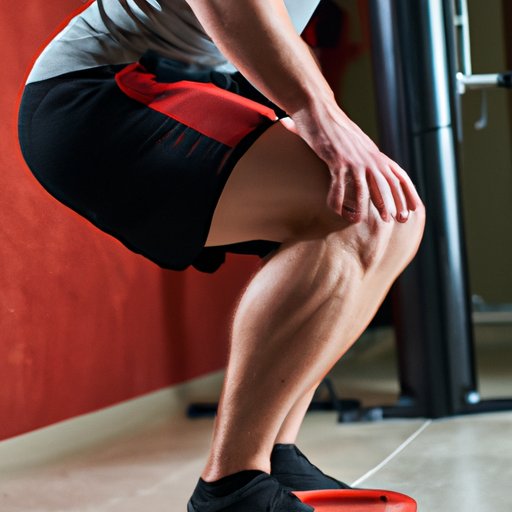Introduction
When it comes to building strength and improving exercise performance, few exercises are as effective as the squat. However, it’s important to remember that the benefits of squatting come from proper form and technique. In this article, we’ll cover everything you need to know to squat properly, including key tips for perfecting your form, the dos and don’ts of squatting, techniques for building lower body strength, expert advice, and step-by-step breakdowns for beginners.
7 Key Tips for Perfecting Your Squat Form
To perform a squat with perfect form, focus on the following key tips:
- Tip 1: Find your foot stance and position. Your feet should be slightly wider than shoulder-width apart, with your toes pointing slightly outward. The position of your feet will depend on your body type and flexibility.
- Tip 2: Brace your core and keep your chest up. Before you start the movement, engage your core muscles and keep your chest up and shoulders back.
- Tip 3: Initiate the movement with your hips. Bend your hips first, then your knees, to initiate the movement.
- Tip 4: Reach proper depth and avoid rounding your back. Aim to reach parallel or slightly lower, keeping your spine in a neutral position.
- Tip 5: Keep your knees out and over your toes. As you squat, make sure to keep your knees in line with your toes, avoiding any inward collapsing.
- Tip 6: Control the eccentric (lowering) phase. Lower yourself in a slow and controlled manner, avoiding any sudden drops.
- Tip 7: Drive through your heels to stand up. As you push up to standing position, focus on driving through your heels and squeezing your glutes at the top.
The Dos and Don’ts of Squatting
Although the squat is an incredibly beneficial exercise, it’s important to take certain precautions to avoid injury and improper form. Follow these dos and don’ts to perfect your squat form:
- Do: Warm up properly before squatting. Spend at least 5-10 minutes warming up your muscles before squatting to prevent injury and improve your range of motion.
- Don’t: Let your knees collapse inward. Keep your knees in line with your toes, avoiding any inward collapsing or excessive pressure on your joints.
- Do: Use a full range of motion. Aim to perform squats through a full range of motion to maximize the benefits and improve your mobility.
- Don’t: Round your back. Keep your spine in a neutral position throughout the exercise, avoiding any rounding or excessive curvature.
- Do: Use compound lifts to build overall strength. Incorporate other compound exercises into your routine to build overall strength and improve your squat form.
- Don’t: Neglect your form for the sake of adding weight. Focus on proper form and technique, avoiding any excessive weight or load that may compromise your form.
Unlocking the Secrets to a Deep and Powerful Squat
A deep and powerful squat requires not only strength but also mobility and flexibility. Incorporate these techniques and exercises to improve your squat depth:
- Importance of lower body strength and mobility. Strong glutes, quads, and hamstrings are essential for a powerful squat, but flexibility and mobility in these muscles are equally important.
- Techniques for building strength in your glutes, quads, and hamstrings. Incorporate exercises such as lunges, deadlifts, and hamstring curls into your routine to build strength in your lower body.
- Stretching and mobility exercises to improve your squat depth. Focus on stretching your hip flexors, glutes, and hamstrings to improve your mobility and reach proper depth.
How to Squat Like a Pro
Expert tips and advice from fitness trainers and professional athletes can help take your squat form to the next level:
- Expert tips from fitness trainers and personal trainers. Consult with a certified fitness trainer or personal trainer to receive personalized tips and advice for improving your squat form.
- Breaking down the squat form of professional athletes and high-level lifters. Analyze the form and technique of professional athletes and high-level lifters to gain insight into proper squat form.
- Common cues and techniques used to improve squat form. Pay attention to common cues and techniques used by experts, such as “push your knees out” and “drive through your heels.”
Squats 101: Mastering the Basics
Before moving on to more advanced variations of the squat, it’s important to master the basic form:
- Importance of mastering basic squat form before progressing to more advanced variations. Perfecting basic squat form will help prevent injury and provide a strong foundation for more advanced variations.
- Step-by-step breakdown of proper squat form for beginners. Follow a step-by-step guide to ensure proper form, focusing on key tips such as foot position, hip movement, and chest position.
- Modifications and progressions to help improve your squat form. Gradually increase weight and incorporate variations such as front or overhead squats to continue improving your form.
Conclusion
Proper squat form is essential for maximizing the benefits of this powerful exercise while minimizing the risk of injury. Follow these tips and techniques, practice proper form, and remember to prioritize safety and progress over adding weight or intensity too quickly. With practice and dedication, you can perfect your squat form and enjoy the many benefits of this effective exercise.
